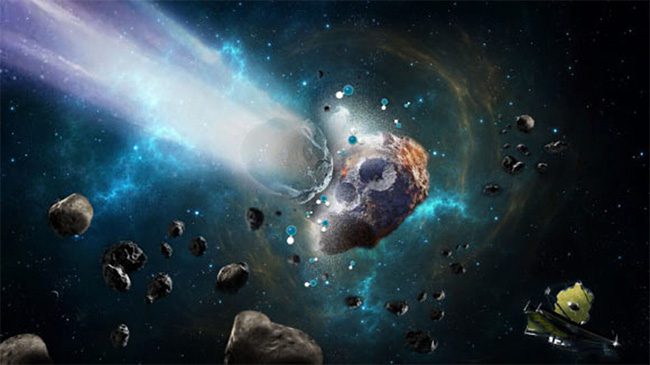Psyche, once thought to be the golden and platinum remnants of a “failed planet,” may originate from the outer regions of the solar system’s asteroid belt.
According to Sci-News, a group of scientists has utilized spectral data from the James Webb Space Telescope to confirm the presence of hydroxyl molecules on the surface of the metallic asteroid Psyche.
These hydrated minerals tell a complex history of the object.
Psyche is a metallic asteroid approximately 226 km in diameter, located in the asteroid belt between Mars and Jupiter.
Scientists believe that this object could be rich in gold, as well as platinum and other valuable metals, making it worth 70,000 to 75,000 times the global economy.

Psyche asteroid located in the dense asteroid belt – (Photo: SwRI).
However, some believe it is primarily rich in iron and nickel.
Other studies suggest that it is not an ordinary asteroid but rather the core of a ninth planet or at least a protoplanet that perished during the early formation of the solar system.
Currently, what interests scientists is its origin, which could explain its metallic richness, regardless of whether it contains gold.
“Our understanding of the solar system’s evolution is closely tied to interpretations of asteroid compositions, especially type M asteroids that contain high metal concentrations,” said Dr. Stephanie Jarmak from the Harvard-Smithsonian Center for Astrophysics.
New data indicates hydroxyl and possibly water on the surface of Psyche. The hydrated minerals could result from external sources, including impact events.
If this hydration process is natural or endogenous, then Psyche may have a different evolutionary history than what current models suggest.
Dr. Anicia Arredondo, a researcher at the Southwest Research Institute (SwRI), stated that asteroids are remnants of planet formation, thus their compositions vary depending on their origin within the solar nebula.
The existence of hydrated minerals on the surface suggests that Psyche may not be a failed planet’s core, but rather a wanderer outside the “snow line” of our solar system.
This is the region where, in the early solar system, the temperature of the protoplanetary disk was low enough for volatile compounds to condense into solids before moving to the main belt.
Moreover, the heterogeneity of the hydration process across different areas of the surface may be explained by impacts from carbonaceous chondrite asteroids believed to have high water content.
Understanding the position of Psyche and other asteroids, as well as their compositions, informs us about how materials in the solar nebula were distributed and evolved since formation.
This also enhances our understanding of how water is distributed in the solar system, which can lead to inferences about water distribution on other planets.
The way water is distributed in our solar system will provide insights into water distribution in other planetary systems and help guide missions searching for life.
This research has just been published in the scientific journal Planetary Science Journal.





















































